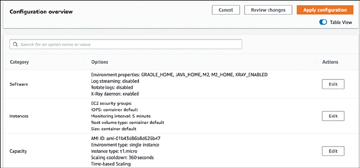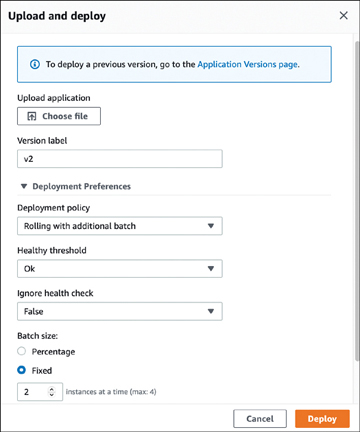Elastic Beanstalk
When moving to the AWS cloud, developers typically have little time and budget but must develop a web application or migrate an existing web app into the AWS cloud while adhering to the company’s compliance standards. The web application needs to be reliable, able to scale, and easy to update. In such situations, Elastic Beanstalk can be of some help.
Elastic Beanstalk, which has been around since 2011, was launched as a platform as a service (PaaS) offering from AWS to help enable developers to easily deploy web applications hosted on AWS Linux and Windows EC2 instances in the AWS cloud. As briefly mentioned earlier in this chapter, Elastic Beanstalk automates both application deployment, as shown in Figure 3-19, and the required infrastructure components, including single and multiple EC2 instances behind an elastic load balancer hosted in an Auto Scaling group. Monitoring of your Elastic Beanstalk environment is carried out with CloudWatch metrics for monitoring the health of your application. Elastic Beanstalk also integrates with AWS X-Ray, which can help you monitor and debug the internals of your hosted application.

FIGURE 3-19 Elastic Beanstalk Creating Infrastructure and Installing an Application
Elastic Beanstalk supports a number of development platforms, including Java (Apache HTTP or Tomcat) for PHP, Node.js (Nginx or Apache HTTP), Python (Apache HTTP), Ruby (Passenger), .NET (IIS), and the Go language. Elastic Beanstalk allows you to deploy different runtime environments across multiple technology stacks that can all be running AWS at the same time; the technology stacks can be EC2 instances or Docker containers.
Developers can use Elastic Beanstalk to quickly deploy and test applications on a predefined infrastructure stack. If an application does not pass the test, the infrastructure can be quickly discarded at little cost. Keep in mind that Elastic Beanstalk is not a development environment (like Visual Studio). An application must be written and ready to go before Elastic Beanstalk is useful. After an application has been written, debugged, and approved from your Visual Studio (or Eclipse) development environment combined with the associated AWS Toolkit, you need to upload your code. Then you can create and upload a configuration file that details the infrastructure that needs to be built. Elastic Beanstalk completes the deployment process for the infrastructure and the application. The original goal for Elastic Beanstalk was to greatly reduce the timeframe for hardware procurement for applications (which in some cases took weeks or months).
Elastic Beanstalk is useful in organizations that are working with a DevOps mentality, where the developer is charged with assuming some operational duties. Elastic Beanstalk can help developers automate tasks and procedures that were previously carried out by administrators and operations folks when an application was hosted in an on-premises data center. Elastic Beanstalk carries out the following tasks automatically:
Provisions and configures EC2 instances, containers, and security groups using a CloudFormation template
Configures your RDS database server environment
Configures your load balancer and Auto Scaling
Stores the application server’s source code, associated logs, and artifacts in an S3 bucket
Enables CloudWatch alarms that monitor the load of your application, triggering Auto Scaling for your infrastructure as necessary
Routes access from the hosted application to a custom domain
Performs blue/green deployments and immutable updates
Elastic Beanstalk is free of charge to use; you are charged only for the resources used for the deployment and hosting of your applications. The AWS resources that you use are provisioned within your AWS account, and you have full control of these resources. In contrast, with other PaaS solutions, the provider blocks access to the infrastructure resources. At any time, you can go into the Elastic Beanstalk configuration of your application and make changes, as shown in Figure 3-20. Although Beanstalk functions like a PaaS service, you can tune and change the infrastructure resources as desired.

FIGURE 3-20 Modifying the Capacity of the Elastic Beanstalk Application Infrastructure
Applications supported by Elastic Beanstalk include simple HTTPS web applications and applications with worker nodes that can be subscribed to Amazon Simple Queue Service (SQS) queues to carry out more complex, longer-running processes.
After an application has been deployed by Elastic Beanstalk, you can have AWS automatically update the selected application platform environment by enabling managed platform updates, which can be deployed during a defined maintenance window. These updates include minor platform version updates and security patching but not major platform updates to the web services being used; major updates must be initiated manually.
Database support for Elastic Beanstalk includes any application that can be installed on an EC2 instance, RDS database options, and DynamoDB. A database can be provisioned by Elastic Beanstalk during launch or can be exposed to the application through the use of environmental variables. You can also choose to deploy instances that are hosting your applications in multiple AZs and control your application HTTPS security and authentication by deploying Application Load Balancer.
Updating Elastic Beanstalk Applications
You can deploy new versions of an application to your Elastic Beanstalk environment in several ways, depending on the complexity of the application. During updates, Elastic Beanstalk archives the old application version in an S3 bucket. The methods available for updating Elastic Beanstalk applications include the following:
All at once: The new application version is deployed to all EC2 instances simultaneously. Your application is unavailable while the deployment process is under way. If you want to keep an older version of your application functioning until the new version is deployed, you should choose the immutable method or the blue/green update method.
Rolling: The application is deployed in batches to a select number of EC2 instances defined in each batch configuration, as shown in Figure 3-21. As the batches of EC2 instances are being updated, they are detached from the load balancer queue. When the update is finished and passes load-balancing health checks, the batch is added back to the load-balancing queue once again. The first updated batch of EC2 instances must be healthy before the next batch of EC2 instances is updated.

FIGURE 3-21 Apply Rolling Updates to an Elastic Beanstalk Application
Immutable: The application update is only installed on new EC2 instances contained in a second Auto Scaling group launched in your environment. Only after the new environment passes health checks is the old application version removed. The new application servers are made available all at once. Because new EC2 instances and auto scaling groups are being deployed, the immutable update process takes longer.
Blue/green: The new version of the application is deployed to a separate environment. When the new environment is healthy, the CNAMEs of the two environments are swapped so that traffic is redirected to the new application version. In this scenario, if a production database is to be used in the application design, to maintain connectivity the database must be installed separately from the Elastic Beanstalk deployment. Externally installed databases remain operational and are not removed when the new Elastic Beanstalk application version is installed and swapped on the application’s EC2 instances.
Traffic-splitting deployments: Canary testing can also be included as part of your application deployment. Elastic Beanstalk can launch a set of new instances with a new version of the application; however, only a specific percentage of incoming traffic will initially be forwarded to the new application instances for a defined length of time. If the new application instances remain healthy during the evaluation period, Elastic Beanstalk then forwards traffic to the new instances and terminates the old instances. If the new instances don’t pass their health checks, all traffic is moved back to the current instances, and the new instances that were under evaluation are terminated, leaving the existing instances online with no service interruption.
